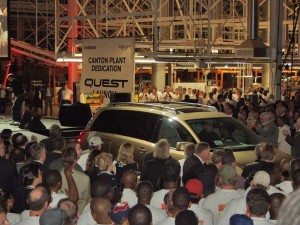Its sales may lag well behind industry giant Toyota, but Nissan North America is now out-producing the transplant operations run by its rival.
In fact, Nissan’s four assembly lines in the U.S. and Mexico turned out more cars, trucks and crossovers than any other transplant network during the first half of 2011 – and will likely need to undergo a major expansion in the near future, company officials tell TheDetroitBureau.com.
Through the end of June, Nissan produced 565,730 vehicles at those four North American plants. Significantly, that was a 9.1% increase over year-earlier levels despite the interruptions caused by the March 11 earthquake and tsunami that tattered much of the automotive supplier network based in Northeast Japan.
Toyota saw production fall 28% during the first half, to 555,972 vehicles, while third-ranked Honda’s North American production network reported a 20.8% drop, to 516,603 cars, trucks and crossovers.
“They did a lot better job” at Nissan overcoming the parts shortages that were created by the March disaster, says Aaron Bragman, automotive analyst with the consulting firm IHS.
Whether Nissan can maintain its lead going forward remains to be seen, but it could prove difficult considering its capacity constraints, company officials acknowledge.
Toyota, arguably hardest hit by the disaster, was forced to cut back North American production by as much as two-thirds in the first few months after the quake. But production is quickly ramping back up, and, “After September we will focus on making-up lost production as much as possible,” Steve St. Angelo, executive vice president of Toyota Motor Engineering & Manufacturing, North America, said last month.
Ultimately, Toyota expects to be able to recover about 350,000 units of production worldwide, though it will still be about 450,000 vehicles short of its original goal for the year. The maker has not said precisely how much of the production lost in North America can be made up.
Honda is also ramping back up and will try to recover lost production in the latter months of 2011. In particular, it will focus on the all-new Civic, which came to market just after the March disaster. John Mendel, chief executive of Honda’s U.S. subsidiary, acknowledged that Civic operations won’t be up to normal capacity until “sometime in autumn.”
While its North American plants have all but recovered already, Nissan has a very different problem to cope with.
Nissan’s original U.S. plant, in Smyrna, Tennessee, is pushing the limits of its 550,000 unit capacity, the newer Canton, Mississippi plant is up to its walls rolling out 400,000 vehicles. The situation isn’t any better in Mexico. The Aguascalientes plant has seen steady increases and is now at 350,000 units capacity, the Cuernavaca assembly line at 261,000.
All told, that is barely meeting current demand in the Americas, especially with CEO Carlos Ghosn . last month indicating U.S. sales should top 1 million in the current fiscal year, a 7.7% increase over the prior year, which ended March 31.
“What’s clear is if we look at our aspirations for growth in the U.S. and the role the (two Nissan) Mexican plants play for our growth in North and South America we’re going to have to have more capacity,” says global marketing chief Simon Sproule.
The executive, based at Nissan headquarters in Yokohama, tells TheDetroitBureau.com that a big increase in capacity is already under study. “Whether that means new facilities or growth in current facilities, that’s something we’re working on right now,” adds Sproule.
The U.S. is just one market where Nissan plans to add capacity. It has to fuel growth in a number of regions, including some key emerging markets, such as China. It has already confirmed plans to add a new factory in Brazil.
The challenge will be to keep up with CEO Ghosn’s ambitious new growth plans. Dubbed Power 88, it projects boosting the maker’s global market share to 8%, while increasing margins to 8%, as well. To get there, Nissan aims to increase sales from a projected 4.6 million for the current fiscal year to 8 million by the end of the six-year project.
Even if Nissan falls short of that roughly 50% increase it will need a sizable expansion in its current production base in the U.S., Europe, Asia and other parts of the world.

